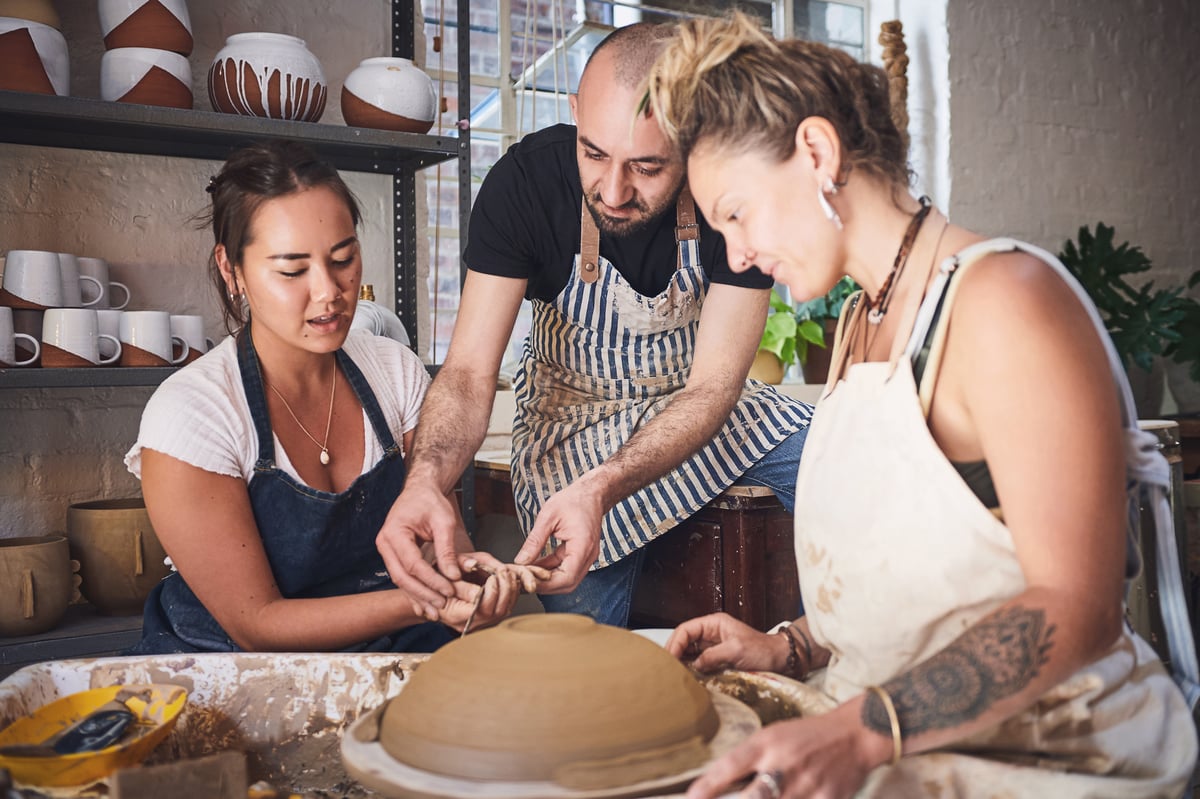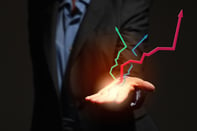Published on
From Apprenticeship to Competency: What Anthropology Can Teach Us About Learning
Jarek Janio | Faculty Coordinator, Santa Ana College
Donald Gaff | Professor, University of Northern Iowa
Imagine a young apprentice kneeling beside a master potter, hands coated in clay, mimicking the careful pressure and rhythm needed to shape a bowl. Across the world and throughout time, this scene has repeated itself in thousands of forms: a child shadowing a hunter, a novice doctor assisting in surgery or a philosophy student testing ideas through dialogue. Learning—real learning—has always unfolded in shared human experience, grounded in demonstration, repetition, feedback and correction.
The science of anthropology reminds us that education has long been an embodied, public practice. For most of human history, skills were not claimed but shown, and proof of learning was never a grade or credential but the competence to act.
Across cultures and centuries, learning was grounded in apprenticeship. A learner watched, listened, practiced and repeated until competence was achieved. Whether in pottery, farming, law or music, instruction was anchored in doing. The master demonstrated a skill, and the apprentice learned by performing it.
Anthropologists show that this model was never just tradition; it was a survival strategy. A poorly built shelter or incorrectly prepared food could endanger an entire community. That’s why cultures developed systems of direct instruction, observation and correction. Mastery had to be visible. Competence meant survival, not symbolic recognition.
Modern education, by contrast, often relies on proxy indicators of learning: grades, diplomas, credit hours and survey data like student evaluations or satisfaction scores. But decades of research have questioned the validity of these measures, with studies showing that grades frequently reflect compliance, test-taking ability or socioeconomic background rather than actual skill acquisition. Diplomas attest to time spent, not necessarily skills learned. Student evaluations, though widely used, have been found to correlate more strongly with instructor charisma or grading leniency than with actual student learning outcomes. In short, these measures may signal participation or perception, but they do not consistently capture what a learner can do.
Behavior cuts through the noise. When students are asked to perform, produce or solve problems in real-world contexts, their learning becomes observable and verifiable. Performance-based assessment rooted in demonstrated action has repeatedly been shown to provide more accurate evidence of skill attainment and knowledge transfer. At the end of the day, we trust what’s done, not what’s declared.
The Power of Visible Learning
Across cultures and contexts, learning has always been grounded in action. Whether in kitchens, workshops or fields, knowledge is passed not through lectures but through shared activity. Ethnographic research affirms it. In the Philippines, for example, William Longacre documented how younger members of the Kalinga community learned pottery not by sitting through lessons but by working alongside skilled elders. They observed, imitated and received corrections. There were words, yes, but no curriculum. Mastery came through repetition, and the finished pot—durable, functional, beautiful—was the only proof needed.
However, this model isn’t limited to hands-on crafts. Even the most theoretical disciplines rely on visible performance. Ancient philosophers taught through dialogue, debate and demonstration. Students didn’t merely memorize axioms; they learned to reason by arguing, questioning and responding to counterclaims. In mathematics, especially in early proofs and geometric theory, learning meant replicating problem-solving processes and defending one’s logic in front of others. Competence was not claimed through test scores but through the ability to construct and communicate sound reasoning.
Ancient astronomy offers another example. Long before modern telescopes, astronomers like Ptolemy or al-Khwarizmi had to observe celestial phenomena and draw conclusions based on patterns and predictive models. Their students learned not just by reading their conclusions but by participating in calculations and tracking planetary movement themselves. Demonstrating skill in observing and recording astronomical events was foundational to learning the discipline.
In all these cases, whether shaping clay, solving a proof, forming an argument or tracking the stars, learning was public, performative and embedded in a community of practice. Observable behavior was the only way to confirm competence.
This view aligns with the behaviorist theory B.F. Skinner advanced. He argued that learning is not an internal state but a change in observable behavior shaped by reinforcement. Skinner’s behaviorism and anthropology, though rooted in different traditions, converge on the same principle: learning must be seen to be assessed. We cannot meaningfully evaluate what students know unless we observe what they can do.
This logic holds, even in teaching values or abstract ideas such as justice, empathy or leadership. We do not understand fairness by defining it; we learn it through action: negotiating, speaking up or making space for others. These are not theoretical achievements but behavioral ones. Classrooms that center performance and application help students internalize these concepts by acting on them.
Reimagining Assessment
Today’s classrooms often prioritize convenience over authenticity. Multiple-choice tests, timed essays and grade curves are scalable and efficient, but they rarely reflect deep or transferable learning. If a potter only memorized clay terminology, they would never make any. If a doctor could list symptoms but never diagnose or treat, they would never save any lives. Outside the classroom, promotions depend on doing the job, not passing a test.
However, many educational systems cling to indirect indicators. These shortcuts persist because they’re easy to standardize and quantify, but the trade-off is high. They often reward surface learning and disadvantage students who lack cultural or linguistic fluency with academic norms.
Behavior-based assessment offers a fairer and more inclusive approach. When we evaluate what students do, not just what they say, we create more pathways to success. Learners from a wide range of backgrounds can demonstrate their knowledge through action. The measure becomes competence, not conformity, and the advantage shifts to those who can perform, not just those who test well.
Fieldwork as a Model
Anthropology offers not just critique but models. Consider how student learning is assessed in archaeological fieldwork. One of the authors has led digs in Iowa where students are not evaluated by their ability to recite theory alone. Instead, they are taught how to dig, document and analyze artifacts in real time. Feedback is immediate and behavioral: “Use the shovel this way,” “Label your bag like this,” “Don’t touch the poison ivy,” “Stay away from the trench edge.” Learning is assessed through observable criteria: careful tool handling, clarity in field notes, accuracy in interpretation and attention to safety protocols.
This emphasis on behavior extends across disciplines, even in fields often regarded as abstract or theoretical. In philosophy, for example, learning historically unfolded through public discourse. From Socratic dialogues in the agora to oral defenses of theses in medieval universities, students demonstrated understanding by articulating ideas, responding to critique and adapting their arguments in real time. Mastery was revealed through dialogue, not memorization.
In mathematics, proofs were traditionally taught by watching experts solve problems step by step, then reproducing the process in front of others. Whether in Euclid’s geometry or modern number theory, the act of doing math writing, calculating and explaining was the evidence of learning. The elegance or validity of a solution could be seen and evaluated.
In literary studies, students show interpretive skill by writing essays, leading discussions or giving presentations that apply theoretical frameworks to texts. The product is not merely a set of ideas but the clear articulation, organization and defense of a perspective—observable and assessable actions.
In the sciences, laboratory courses require students to follow procedures, record data and interpret results. Learning is not confirmed by reading a lab manual but by safely and accurately completing an experiment. Even in astronomy, perhaps the oldest of the theoretical sciences, students once learned by charting stars, calculating planetary positions and building models to explain visible phenomena. Their learning, like their predecessors’, became evident in prediction accuracy and the methods used to reach them.
In all these cases, knowledge is inseparable from behavior. Across the humanities, sciences and arts, competence takes shape not through recall but through performance. The classroom becomes a site of practice, not just preparation.
Assessment in these settings is grounded in observable benchmarks: precision, consistency, appropriate technique and contextual judgment. What students know is inseparable from what they do. And while the excavation site may seem worlds apart from a philosophy seminar or a math classroom, the underlying principle remains the same: Competence is demonstrated through action. From nursing labs to literary analysis, studio critiques to statistical modeling, learning becomes meaningful when it is made visible through performance in specific contexts.
Returning to What Works
Reclaiming assessment practices rooted in observable behavior is not a return to some nostalgic past. It is a reorientation toward what has always worked: competence through demonstration. In an era of growing skepticism about higher education’s value, this shift is also a path toward credibility. When we show what students can do and those skills are relevant and real, we may restore confidence in education.
Anthropology reminds us how humans have always learned: through observation, repetition, correction and performance. Behaviorism sharpens that view by showing us that learning is visible in action. Together, they challenge us to build assessment systems rooted not in recall but in demonstration. What if courses were designed around what students must do, not just what they must know? What if final exams became performance projects, solutions or real-world tasks? What if grades reflected skills in motion, not memories on paper?
We already rely on performance in the world beyond school: to certify a pilot, evaluate a surgeon or hire a carpenter. It’s time our classrooms caught up. If we want to assess learning honestly, we must begin where learning has always lived—in behavior—not because it’s simple but because it’s true.



